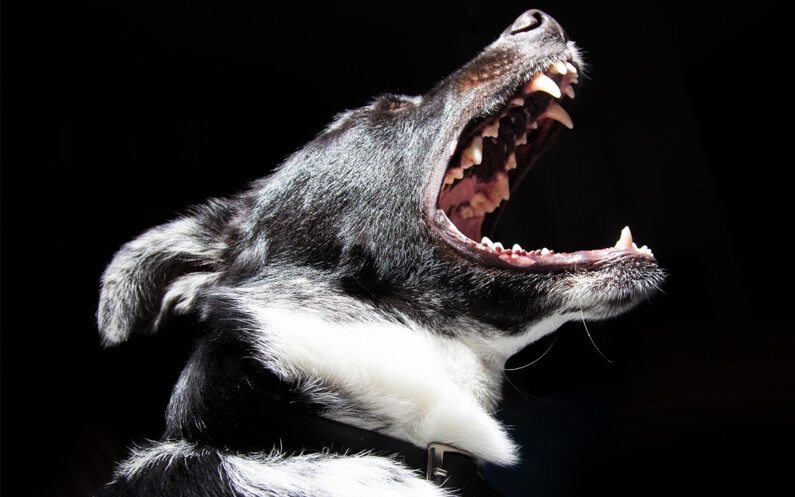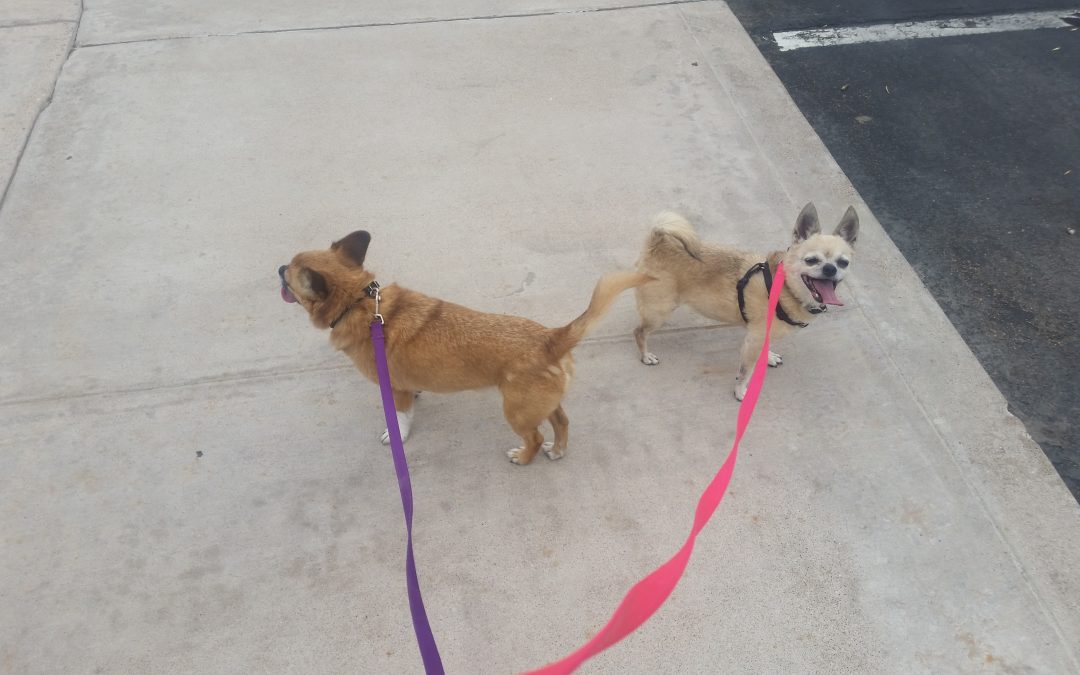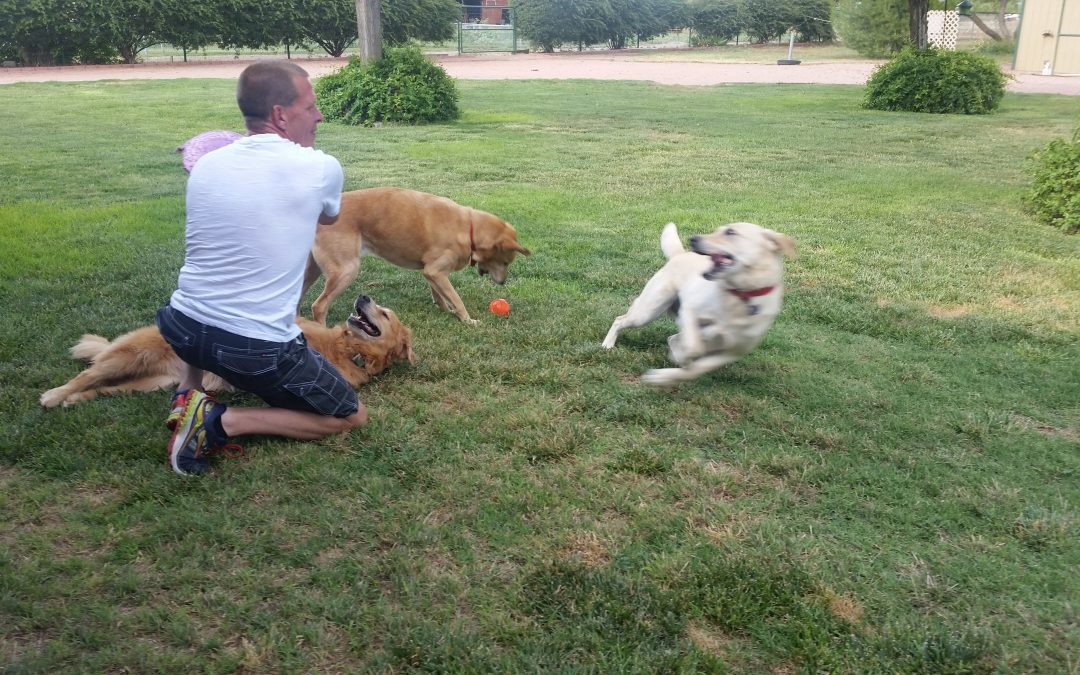
Pet Care, Pet Training
Aggressive Dogs
How to Spot Fear & Aggression in Dogs
News headlines are constantly highlighting dog attacks. As such, even more dogs are being euthanized in shelters as they are deemed aggressive, dangerous and unpredictable. Would it surprise you to hear that all of this would be preventable with a basic knowledge of canine behavior?
The Fearful Attacker
It is true that no dog attacks without reason, and almost every time that reason is that his body language was ignored. The vast majority of dogs who bite, bark, growl or lunge do so out of fear. Something occurred, whether you can see it or not, that made the dog feel threatened and fearful. His language was ignored, and thus he reacted in the only way he knew to protect himself. Other behaviors can come into play as well, such as resource guarding which is another fear based behavior. Remember being told as a child to not pet an eating dog? It is because a dog with resource guarding problems may lash out if prompted, even when you are just trying to be his friend.
The fearful dog who causes harm to a human or other animal is a serious danger. The people and animals around him can become hurt or even killed, which also puts his life in danger. If your dog has a bite history or at risk of biting, don’t try to train him yourself! You need a specialist or experience animal behaviorist to help your dog get a better grip and understanding of the world around him. This expert help will keep you all safe!
Unpredictable Shelter Dogs
Shelter dogs are often characterized as aggressive dogs. Dogs who are healthy and yet considered non-adoptable according to a shelter’s temperament testing system also falls into the category of being misunderstood. These dogs are in need of help and are often just scared. A scared dog will act in the only way he or she knows, which is to protect themselves from harm. This is often seen as an aggressive dog.
Considering a dog has no ability to understand what humans are telling them, they have no idea if the next person that walks into their kennel, picks up their food dish or puts a leash on them will cause them harm or not. The human may unknowingly provoke the dog by moving their body in a manner that gives the dog reason to be fearful, such as walking straight up, bending over the dog, reaching a hand towards the dog and even eye contact.
There is hope for these shelter dogs if they are given a chance. The fear in them can be changed through the training method called counter conditioning. It is a simple, but time consuming tactic based on the premise of changing a dog’s emotion over his trigger. The trigger can be a human, another dog, or even loud noises.
Counter Conditioning for Fear in Aggressive Dogs
Teaching a dog to accept something that he is terrified of can be challenging. It can take from a few days to months to change how a dog feels about something, but it can be done! Counter conditioning is the act of doing just that, and it requires patience, time and consistency. Get started with a handful of irresistible treats and the dog’s trigger at such a distance that the dog hardly notices. Every time the dog acknowledges the trigger without reacting, give him a treat. Work up, over time of short sessions, to having the trigger within only a few feet from the dog without him reacting. When you get to that point, you can call it a big success!
Dogs who are euthanized or have lashed out, bitten or snarled over resource guarding is a terrible tragedy. Resource guarding is a natural behavior that even the dog’s wild cousins, the wolves’ exhibit. Resource guarding is when a dog feels protective over an item, food, or even a person or another dog. This is the dog’s fear of that item being taken from him. Even this dangerous and overly common behavior can be trained out of a fear aggressive dog, sometimes within days!
Don’t Throw In The Towel!
It is extremely rare that a dog may be beyond the ability to rehabilitate or reform in their fearful and aggressive behaviors. Professional help is often times the best answer, but those few who are lucky enough to have the natural ability to communicate with dogs and are educated in the theory of training can effectively treat or even cure fear aggressive behaviors. Learn all you can, and never throw in the towel!
For More Information
If you have questions about aggressive dogs or questions about pet care, you can contact Kara Jenkins, Owner of TLC Pet Sitter. We are also available by email at info@tlcpetsitter.com.

Pet Care, Pet Training
6 Tips for Dog Walking
Even if you do not like it, your dog definitely likes to take a stroll. You may be surprised by these tips for dog walking. After all, dog walking seems pretty easy. Dog walking is essential for maintaining your pet’s health and keeping them happy and active. Therefore, if you do not have the habit of taking your dog out every morning or evening, you should get started with at least twice a week and let the habit build. Dog owners will enjoy these tips for dog walking. They will help you master the art of dog walking sooner than you think.
1. Lead your dog
Always walk in front of your dog or by its side. If your dog is ahead of you, it will keep dragging you along with it and you will never know who is walking whom. Dogs are naturally programmed function in packs so they will only find it natural if you lead them. Make sure you are the first one to step outside your house every morning and the first one to step in when coming back from the walk.
2. Switch to shorter dog leash
Many believe that having longer leashes would allow your dog to walk freely, but longer leashes mean less control and increased chances of your dog running in the middle of the road with you running after. Shorter leashes allow you greater control on your dog and you can easily direct and train them. However, when buying the leash, make sure it is not hard on the skin and not hazardous in any way.
3. Set aside fixed hour each morning
Dogs are diurnal and they like morning walks, so set aside an hour every morning for the walk. However, the need may vary from breed to breed, so have your dog’s vet tell you how much time a day would be suitable for your dog’s health.
4. Let your dog sniff around
Dogs like to sniff around. It is their playtime activity and they enjoy it more than anything else. This is how they gather all the information about what is going around them. You as a dog owner should know how important this walk is for their health and mental stimulation. If you do not want to stop at every step while your dog sniffs every next thing, you can loosen the leash for a bit after a while so you can walk without constantly running after your dog.
5. Do not forget to treat your dog!
Dogs are famous for learning through reinforcement method – treat them when they behave good to promote that behavior and turn it into habit Every time you complete a run or a walk with your dog, treat them with their favorite meal and give them plenty of water to replenish from the walking and sniffing. By doing this, you will be conditioning your dog in a way through which they will look forward to daily walks.
6. Clean what he leaves behind
A good dog walker is also a good citizen. Clean up dog poop if they leave any on the walk and properly dispose it off. It won’t be a pleasant thing to do, especially when you are out on a good sunny day but it only makes you a good dog owner and a responsible neighbor.

Pet Care, Pet Health, Pet Training
Responsible Pet Ownership
Responsible pet ownership is nothing less than caring for a child. Luckily, most pet owners do consider their pets a part of their family. However, loving is not enough when it comes to being a good and responsible pet owner. Just like you work on raising your child, work on his education, make sure he is eating a well-balanced diet, his hygiene is maintained; you do the same with your pet as well. If you are wondering what should you do to become a responsible pet owner and how it is more than just loving your pet, continue reading the post.
Caring for Your Pet’s Physical Health
Taking care of your pet’s health – It does not matter if you have gotten your pet vaccinated or not, regular checkups are must. With us humans, we can easily tell if something is not okay or not feeling well, but since we don’t speak the language of our pets, we don’t really know what might be going inside their body and how they are feeling. This is why it is important that you get their monthly physical check-up scheduled. Your pet’s health includes making sure they are free from fleas and parasites which can be sucking onto them and eventually weakening your pet. Also, get your pet’s teeth brushed twice a day as well.
Caring for Your Pet’s Diet
Healthy and balanced diet – Like every living being, your pet also needs a complete diet that’s a combination of fats, carbs and proteins to maintain a healthy gut system. Homemade pet food is the best option for pet food. However, even if you are buying instant pet food, make sure it contains the daily nutritional requirement of your pet. Also, do not feed your pet too much. Diabetes and obesity does not only exist in humans. It can also affect your pet and make them sick and lethargic.
Spay and Neuter Your Pets
Be sure your pet is spayed or neutered – Some might think this practice is unethical, but pet overpopulation has become a serious problem because not everyone is a pet lover nor there is enough space in pet shelters. Which is why getting your pet neutered is important to control the pet overpopulation. It also reduces the risk of your pet getting testicular cancer and other health risks.
Being Prepared
Be prepared for pet emergencies – Just as you always make sure to keep a baby bag prepared with all the baby essentials in it, you have to do that for your pet too. Keep all the emergency supplies ready in a kit including eye ointments, vet wraps, gauze, hydrogen peroxide, anti-septic, and tweezers. Also, keep a pet first aid book at hand, especially when travelling with your pet in a car.
Basic Training
Timely training – We are not just talking about professional training here; basic training is equally important for your pet. It stimulates their mind and keeps them active and happy. Reward based training is known to help in promoting good mental health in your pet and enhance the relation between the pet and owner. Training also conditions and eliminates violent habits from your pet’s behavior, making them friendly and calm.
For Puppies, Pet Care, Pet Training
Socialization for Dogs
While many dog owners believe their dog to be the friendly sort, and they very well may be, the act of socialization goes far beyond just saying his to house guests. It goes beyond meeting new people, trips to the Dog Park and doggy play dates, too! Socialization includes items that may be strange to a dog, different floor textures, sounds that can be scary and more. You can start your dog, at any age, down the road to being well socialized with patience and care.
The Fear Periods
While all dogs are continuously learning throughout their lives, including socialization, the two fear periods in a puppy’s growth are probably the most impressionable. These two times in your puppy’s life are when objects, people, other animals and dogs can hardwire a certain emotion and reaction in your dog. The experiences he has during his fear periods are the ones that he will carry with him for the rest of his life, even the bad ones. This is why trainers, breeders, rescuers and veterinarians always stress socialization during puppy hood, because these emotions and behaviors that your puppy learns at this time become difficult to change in the future.
The first fear period
The first fear period will begin before your puppy is even weaned at four weeks old. If your puppy came from, or is coming from a breeder then it is up to your breeder to begin socialization at or before this time in your puppy’s life. The same can be said for a rescue or shelter! It is incredibly important for a puppy at the beginning of his four weeks of life to begin learning new things and have a positive exposure to things that may seem scary to a dog. This first fear period ends at about twelve weeks of age, which means you will receive your puppy during his first fear period! This is a prime opportunity to begin training immediately and form a wonderful bond with your puppy.
The second fear period
The second fear period is a guess, as each individual puppy may be slightly different. It can occur anywhere between seven and eight months of age and lasts for two weeks. During this time you may see more flighty behavior from your puppy, hence the name fear period! It helps to know your puppy well so you can realize quickly that he has entered his second fear period. While socialization should be taking part on a regular basis no matter what your dogs’ age is, this is the most ideal time to introduce him, or reinforce socialization with items and people specifically as well as work on preventative training so your dog will not become reactive in the future.
Exposure vs. Experience
Exposure is needed to socialize a dog, whether you are working on introducing him to umbrellas or other animals. However, exposure alone will not socialize your dog! The key to a well socialized dog is the brief, positive experience he goes through while the exposure is taking place. This does not mean you need to give your dog a treat after he cautiously explore a scary hat on the ground, but instead encourage him to explore it more and when he’s done give praise and move on. It literally can take minutes to socialize your dog with an item!
Nothing Forced
When it comes to socializing your dog with people, especially if you have a shy dog, the trick is not to force him to allow others to pet him. Forcing your dog to let strangers put their hands on him will work against you in socialization. If your dog is shy, let him just observe people, and when a stranger asks to pet your dog don’t feel obligated to let them. Just kindly tell the person your dog is in training, and most people will happily accept and understand to respect your dog’s space.
When your dog becomes interested in the people, and not providing fearful or cautious behaviors, like leanings towards someone without stretching out his back legs (as this allows him a quick exit,) you can allow a person to pet him. Ask the person to kneel at his level, while providing their side not chest in his direction and let your dog approach. This makes the person look inviting instead of threatening, and gives your dog the ability to have a positive social experience with a stranger. Once should be plenty for a shy dog, but an outgoing pup may want to meet humans as many as possible!
Never Stop
Dogs learn for life. No dog is too old to learn new things, not even socialization! If you adopted an adult or senior dog, don’t feel as if you don’t need to help him become comfortable with new or strange things. Even if something is scary to him, he will love to learn something new and be more confident instead of fearful. Never stop teaching any dog new things, especially when it comes to socialization!
For Puppies, Pet Care, Pet Safety, Pet Training
For pet owners, a crate may offer several benefits such as: aiding with house training (as dogs do not like to soil the area where they sleep), limiting their pets’ access to the rest of the house, and as a safe way to travel. However, for a dog, a crate is much more. Dogs are instinctively den animals. Their crates serve as their “den.” Dogs prefer using their crates as a safe place to sleep or take refuge, just as they would use a den to do so in the wild.
Crating Precautions
It is important for owners to foster that sense of security that a dog feels about their crate rather than creating a mood of feeling trapped or frustrated. Some common mistakes that would cause a dog to experience anxiety while crating them would be: to use a crate as punishment, to leave a dog in their crate for too long without getting human interaction or exercise, confining puppies in crates for longer than 3 hours (which is too long for a puppy to be expected to hold his or her bladder).
Picking the Right Crate for Your Pet
A crate should be the right size for your dog, which would allow your dog to stand up and turn around comfortably. A crate that is too large may be more difficult to use while house training a dog, since the dog may have room to potty in one corner and sleep in another. Some options for puppy owners are: renting a smaller crate from a local animal shelter until their puppy is full grown, and then purchase a crate that is the right size for their full grown dog or simply blocking off the excess crate area while the puppy is small.
Crate Training Tips
Crate training should only take days or weeks depending on each individual dog. Owners should make sure that the process is a positive one for the dog and that they are going at the dog’s pace and not forcing it. Here are some simple steps to make the process go smoothly:
- 1. Introduce the dog to their new crate- Place the crate in an area where the dog is comfortable and make the crate a relaxing get-away by placing a blanket, towel, toys, and/or treats inside. The dog will become naturally curious about the crate and want to check it out.
- 2. Feed near the crate- A dog will begin to develop a positive association between the crate and meal times, if fed nearby the crate.
- 3. Start with short intervals- Owners should first crate their pets for short periods of time while still home, to get them used to the idea.
- 4. Crate when leaving home- Once the dog has shown that he/she can be crated for longer and longer intervals without anxiety, then they are ready to be crated while the owner leaves home. Owners can use a command and/or treat routinely to prompt their dogs to enter the crate.
- 5. Crating through the night- At first, owners should place the crate near their bedrooms, so their pets can feel secure that they are close to their owners while still crated. Puppies and older pets should be let out to potty even during the night, as their bladders are not capable of holding through the entire night. The owner can then incrementally move the crate further and further away from the bedroom, once the pet has become accustomed to sleeping in the crate overnight.
Potential Side-Effects
Although crate training does offer many benefits to both owners and pets, owners should be aware of some side-effects along the way. While crate training, puppies especially, may whine or cry. Although it is important to make sure that you are not reinforcing the whining behavior by letting the dog out of the crate prematurely, it is also important to give the pet plenty of opportunities to potty. One way to do so would be to have potty breaks at specific times so the pet has a routine, and knows to expect a potty break at a certain time rather than whenever he/she whines. Another possible side-effect is separation anxiety, which may be managed through consulting with a professional animal-behavior specialist. If a pet is displaying signs of hurting himself/herself while attempting to escape the crate or of being especially destructive, please seek help for your pet in order to overcome their separation anxiety.
Information obtained from Human Society 8/17/11. For more information on this topic and many others, please visit their website at: www.humanesociety.org



